Musical instruments are an indispensable part of the culture and music of every nation. With over 54 ethnic groups, Vietnam boasts a diverse and rich musical history, featuring distinctive traditional musical instruments. Encompassing a rich and varied musical landscape, traditional instruments have gradually embedded themselves in the people’s hearts, becoming symbols of unity and cultural diversity in Vietnam.
Let’s explore some traditional musical instruments of Vietnam through this article.
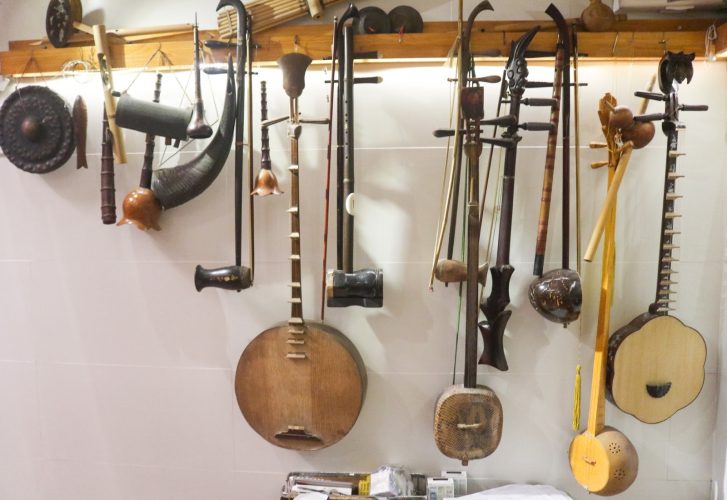
Dan Nhi

The Dan Nhi, a two-string fiddle, stands as a testament to the soulful melodies deeply rooted in Vietnamese musical traditions. Crafted with precision, its slender frame supports two strings that resonate with a hauntingly beautiful sound. Traditionally played with a bow made of horsehair, the Dan Nhi has become a staple in Vietnamese folk music, adding a distinctive touch to various genres.
This traditional instrument holds a special place in the hearts of musicians and listeners alike, as its emotive tones convey the essence of Vietnamese cultural stories. The Dan Nhi’s versatility allows it to adapt to different regional styles, making it a key player in the diverse musical landscape of Vietnam, including Hát Xẩm, folk music, chamber music, cải lương (traditional Vietnamese opera), and tài tử (a genre of traditional Vietnamese chamber music).
Sáo Trúc – Harmony in Bamboo Tubes

The soulful melodies of Vietnam often find their expression through the enchanting tones of the sáo trúc, a traditional bamboo flute. Crafted from a hollow bamboo tube with meticulous finger holes, the sáo trúc is a testament to the nation’s pastoral and romantic roots.
The simplicity of the instrument belies its versatility. In the hands of a skilled musician, the sáo trúc becomes a conduit for expressing the spiritual and philosophical aspects of life. Played solo or harmonizing with other traditional instruments like đàn tranh or đàn bầu, the sáo trúc weaves tales of Vietnamese landscapes and the deep connections between nature and humanity.
The Vietnamese 36-chord zither
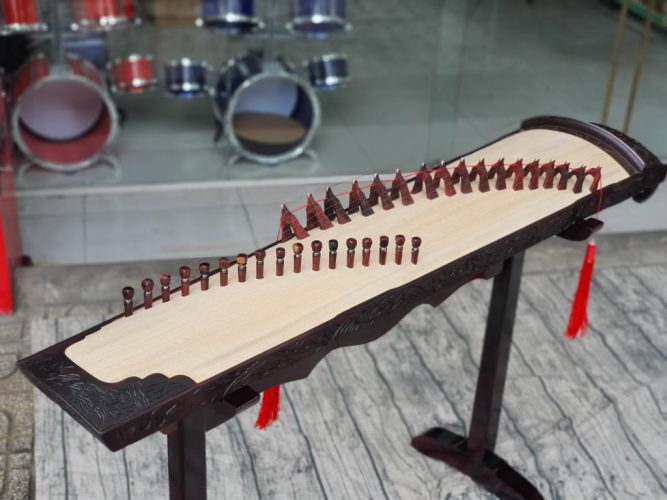
At the heart of Vietnam’s musical heritage lies the đàn tam thập lục, a plucked zither boasting 36 strings. Known also as the đàn tranh, this instrument produces a bright and lively sound, enchanting audiences with its intricate melodies and harmonies.
The đàn tam thập lục stands as a testament to Vietnamese sophistication in musical expression. Whether in the classical tunes of nhạc tài tử or the folk tunes of nhạc cổ điển, its strings resonate with tales of centuries past. As fingers pluck, bend, and slide across the strings, the đàn tam thập lục narrates stories of beauty, grace, and intelligence ingrained in Vietnamese culture.
Đàn Bầu – The Unique Monochord

In the realm of Vietnamese traditional instruments, the đàn bầu emerges as a one-of-a-kind monochord. With its haunting and ethereal sound, this instrument is a soul-stirring echo of Vietnamese emotions and nostalgia.
Crafted from a wooden soundbox, a single metal string, and a bamboo rod, the đàn bầu is more than a musical instrument; it is a storyteller. Plucked with a plectrum and manipulated with the left hand, the đàn bầu captures the essence of sorrow and longing. As its notes reverberate, listeners are transported to a realm where time stands still, and emotions find a voice.
Cồng Chiêng – Resonance of the Highlands
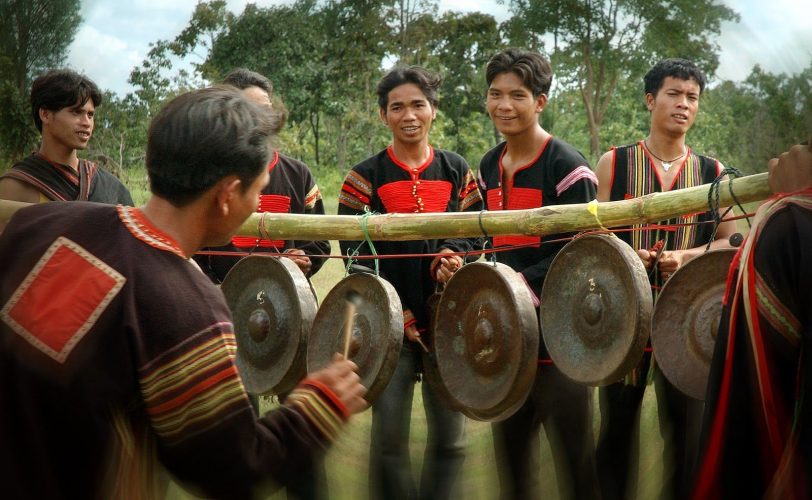
In the highlands of Vietnam, the cồng chiêng, or gong, resonates with power and mystique. Fashioned from circular metal plates struck with bamboo mallets, the gong produces tones that vary in pitch and force.
Beyond its musical role, the cồng chiêng holds a sacred place in the mountainous cultures of Vietnam. Used in rituals, ceremonies, and festivals, it embodies a spiritual connection to the natural and supernatural realms. The cồng chiêng, with its rich resonance, stands as a symbol of wealth, status, and identity in the vibrant tapestry of Vietnamese mountainous cultures.
Khèn – Connecting Communities through Sound
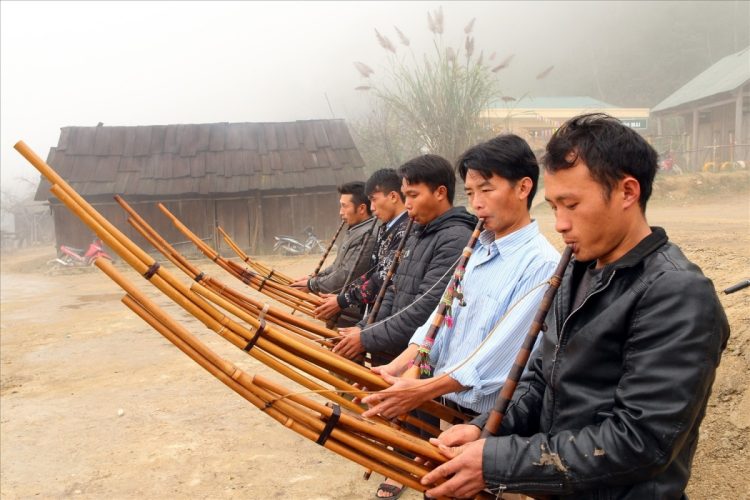
As a wind instrument, the khèn, or mouth organ, creates a rich and vibrant soundscape that resonates across Vietnamese mountainous cultures. Crafted from wood or bamboo, the khèn features multiple pipes, each with a metal reed, allowing players to produce both melodies and chords.
In love duets, spring festivals, weddings, and funerals, the khèn articulates the emotions and experiences of the people. Its harmonious tones symbolize love, joy, and solidarity in the diverse cultural landscape of Vietnam’s mountains.
Đàn T’Rưng – Echoes from the Central Highlands
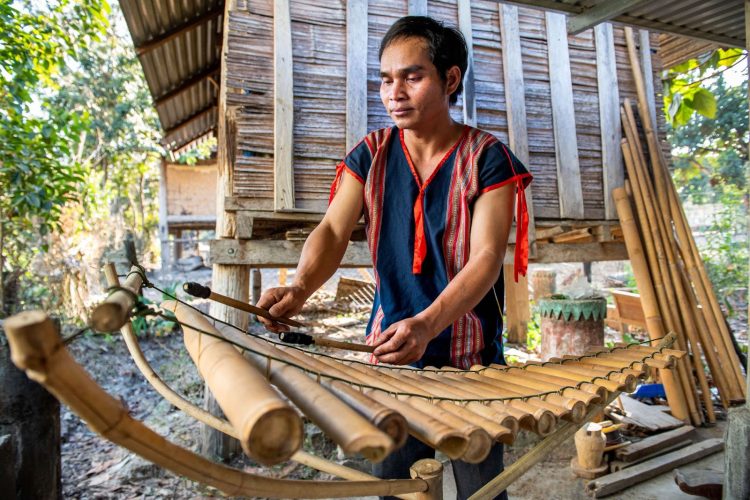
In the Central Highlands, the đàn t’rưng, also known as the bamboo xylophone, emerges as a percussion marvel. Its clear and melodious tones resonate with the landscapes of this region, reflecting the creativity and spirituality of its ethnic communities.
Hung from a wooden frame, bamboo tubes produce varying pitches when struck with bamboo sticks.
Originating from the ethnic groups of the Central Highlands, such as the Jarai and Bahnar, the đàn t’rưng holds a significant place in their cultural and spiritual practices.
Đàn Đáy – The Harmonious Resonance of Three Strings

The đàn đáy, a three-stringed lute, introduces a harmonic resonance to the spectrum of Vietnamese traditional instruments. Crafted with meticulous attention to detail, the instrument features a long neck, a resonator covered with python skin, and three strings made of silk or metal. The player plucks the strings using a plectrum, creating a warm and expressive timbre.
Widely used in the genre of Ca Trù, a traditional Vietnamese chamber music, the đàn đáy is integral to the captivating performances that unfold in this unique art form. Its ability to convey a wide range of emotions, from melancholy to exuberance, makes the đàn đáy a versatile instrument in the musical landscape of Vietnam.
Song Loan – The Rhythmic Director

The Song Loan, also known as Song Lang, plays a pivotal role in orchestras and traditional Vietnamese opera known as Cải Lương. This percussion instrument, often seen as a pair of wooden slit drums, directs the tempo and rhythm of other instruments in the ensemble.
The Song Loan’s distinct, sharp sound marks key transitions in the musical compositions, guiding the musicians and captivating the audience. Its presence underscores the importance of rhythm and coordination in traditional Vietnamese music, adding a layer of complexity to the sonic landscape.
Sênh Tiền – Echoes of Coins

Sênh Tiền, also known as the coin clapper, is a unique percussion instrument that incorporates coins into its structure. Consisting of multiple bamboo tubes, each containing one or more coins, the Sênh Tiền creates a rhythmic sound when shaken or struck.
Embedded in cultural and religious practices, the Sênh Tiền often accompanies ceremonial rituals and traditional performances. The rhythmic interplay of the coins adds a distinctive texture to the overall auditory experience, symbolizing prosperity and spiritual resonance.
Hue Royal Court Music: A Cultural Heritage of Vietnam
Xoi Gac Recipe: How to Make Vietnamese Red Sticky Rice






